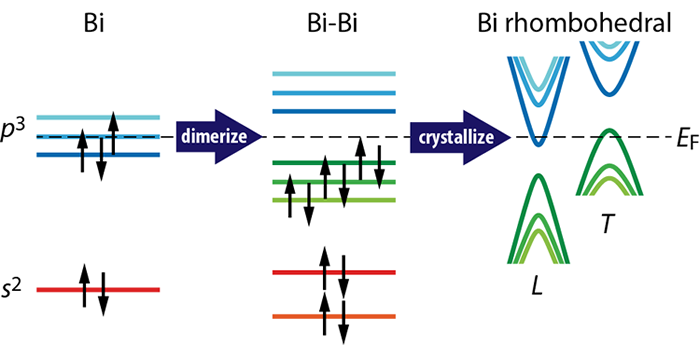June 2015 Issue
Research Highlights
Physics of semi-metals: Insights into electron transport in bismuth
Bismuth is a semi-metal which, in crystal form, exhibits unusual but important properties such as large 'diamagnetism', which stems from particular electronic states. These peculiarities can be exploited to create new spintronics and optical devices, yet the exact mechanisms behind electron transport and behavior in bismuth are not yet fully understood.
To consolidate progress in this field, Yuki Fuseya from the University of Electro-Communications, together with Masao Ogata at the University of Tokyo and Hidetoshi Fukuyama at Tokyo University of Science, studied theoretically the optical and electronic transport properties of bismuth.
A diamagnet produces a magnetization in the opposite direction to an external applied magnetic field, meaning it is repelled by the applied field. Diamagnetism in bismuth takes its maximum value when the chemical potential is located in the band gap, or its insulating state. This so-called 'interband' effect occurs in the presence of large spin-orbit coupling, and is a feature unique to bismuth.
The authors showed that this same mechanism gives rise to other important phenomena such as the weak-field Hall effect and spin Hall effect. These relationships could be exploited, with wide-reaching applications in spintronics - the development of new devices that make use of the intrinsic angular momentum of electrons as well as their charge. By using circularly polarised light and tuning its frequency in insulating states, for example, the team predicted a 100% spin-polarised magneto-optical current, which could have useful applications.
Such a comprehensive description of the physical properties of bismuth in terms of the electron dynamics provides an excellent basis for further studies on bismuth as well as other related materials.
Reference
Yuki Fuseya1, Masao Ogata2, and Hidetoshi Fukuyama3, Transport Properties and Diamagnetism of Dirac Electrons in Bismuth, Journal of the Physical Society of Japan, 84, 012001, (2015).
- Department of Engineering Science, University of Electro-Communications, Chofu, Tokyo 182-8585, Japan
- Department of Physics, University of Tokyo, Bunkyo, Tokyo 113-0033, Japan
- Research Institute for Science and Technology, Tokyo University of Science, Shinjuku, Tokyo 162-8601, Japan

By dimerization, an energy gap opens, which lowers the total energy: the system becomes an insulator. The actual crystal structure of Bi is obtained by adding small lattice distortions. These distortions hybridize the conduction and valence bands, thus the system can gain the kinetic energy of carriers and further reduce its total energy, i.e., it undergoes the Peierls transition.


